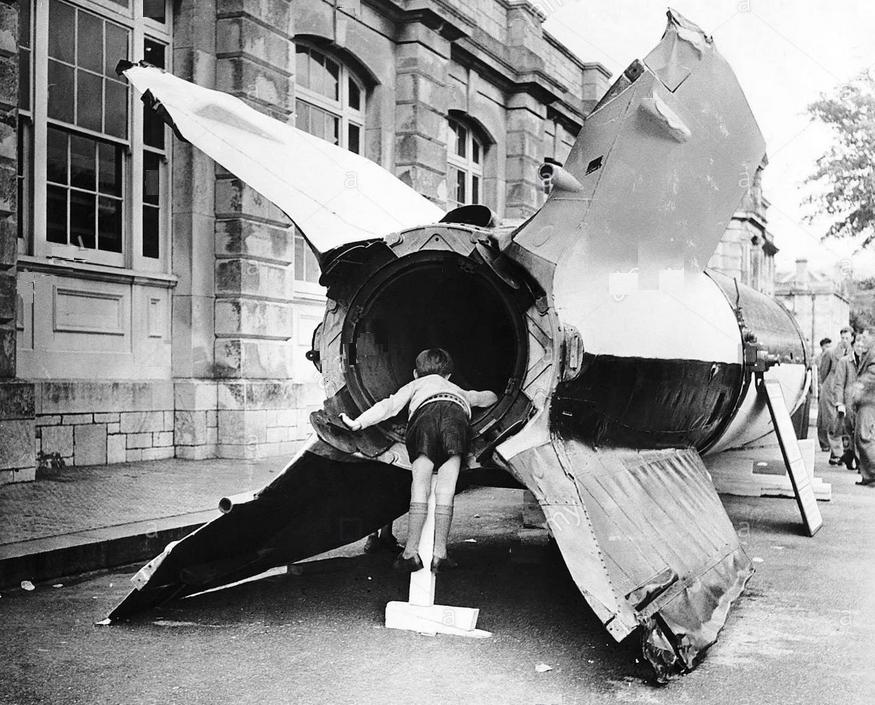
World War II German V-2 Program: Terror Campaign--Range and Speed

Figure 1.--By the time that the Germans brought the V-2 on line (September 1944), they no longer controlled France. And with the failure of Market Grden (October 1944), the only place controlled by the Germans that was within range of London was the Wesrern Netherlands north of the Rhine. There were other targets, but it was London Hitler wanted to hit. The V-2 had a range of 200 miles. This meant the Germans could hit the northeastern corner of England. The other major target was Antwerp to oprevent the Allies from using the port. Other targets includes Paris, other cities in England, France, Belgium, and the Netherland, even the Remagen Bridge. But what Hitler wanted to hit most intensely was London. It was London that had first defied him and he passionately desired another opprtunity to destroy it. Here an English boy looks into the rocket motor of a V-2 at the Royal Navy Devonport Docks near Plymouth. This was far beyond the range of the V-2. We are not sure if this was a V-2 fired ar England or brought from Germany after the War. This was probably the case as it is all in one piece.
|
|
The V-2 had a range of 320 km (200 mi). While the Germans held France and Belgium, London and much of southern and eastern England was in range. As the Germans were not able to begin the V-2 campaign until the liberation of France was largely completed and most of Belgium was liberated, their launch area was significantly restricted, basically the western Netherlands. And this was even further restricted after Market Garden to areas north of the Rhine. Other targets like Antwerp and Paris were in range, but it was London that Hitler wanted to hit. After the failure of the Allies to cross the Rhine as part of Market Garden, the Germans still had areas of the western Netherlands to launch V-2s on London and the southeastern corner of England.
The only limit on the V-2 launches was production and the ability of the Germans to trasport the missles to the western Netherland. Unfortunately, this was one of the last areas liberated from the NAZIs. The missles were to be produced at Peenemünde when the Operation Hydra (August 1943) forced the Germans to move production to the underground Dora-Mittelbau in the Kohnstein (Thuringia) where 5,200 V-2 rockets were built using brutakized slave labor. The underground assembly area was invulnerable, but the rail lines to and from the Dora-Mittelbau were not. The V-2 launches gradually declined as the Allied strategic bombing campaign methodically destroyed the German rail network. This made it difficult to both deliver the needed raw materials to the underground production facility and then to deliver the assembed V-2s to the launch sites in the Western Netherlands. The V-2 had a maximum speed of 5,760 km/h (3,580 mph) and at impact 2,880 km/h (1,790 mph). It dropped from an altitude of 100–110 km (62–68 mi) at up to three times the speed of sound. People on the ground had no warning. No air raid warning, just a sudden, maassive blast.
CIH -- WW II

Navigate the CIH World War II Section:
[Return to Main V-2 terror campaign]
[Return to Main German V-2 page]
[Return to Main World War II European air campaign page]
[Biographies]
[Campaigns]
[Children]
[Countries]
[Deciding factors]
[Diplomacy]
[Geo-political crisis]
[Economics]
[Home front]
[Intelligence]
[Resistance]
[Race]
[Refugees]
[Technology]
[Bibliographies]
[Contributions]
[FAQs]
[Images]
[Links]
[Registration]
[Tools]
[Return to the Main World War II page]
Created: 8:07 PM 1/4/2019
Last updated: 8:07 PM 1/4/2019



